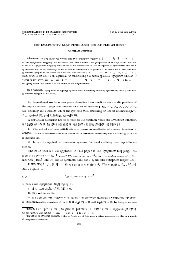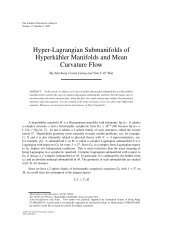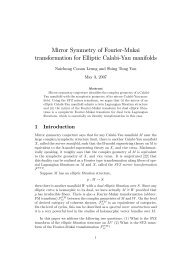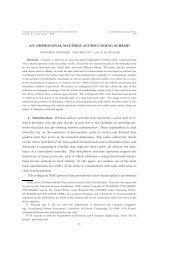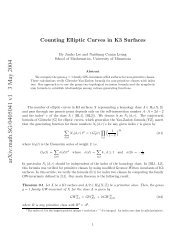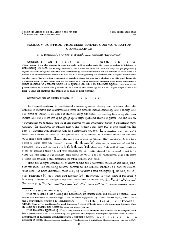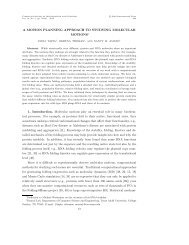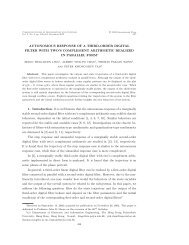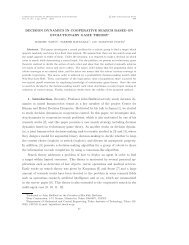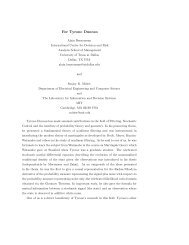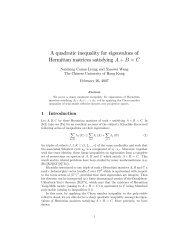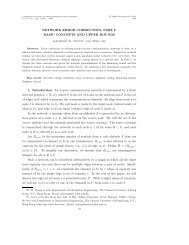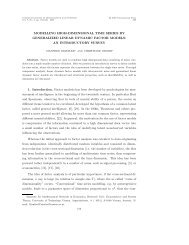AN OPTIMAL DISTRIBUTED ROUTING ALGORITHM USING DUAL ...
AN OPTIMAL DISTRIBUTED ROUTING ALGORITHM USING DUAL ...
AN OPTIMAL DISTRIBUTED ROUTING ALGORITHM USING DUAL ...
You also want an ePaper? Increase the reach of your titles
YUMPU automatically turns print PDFs into web optimized ePapers that Google loves.
280 PUNYASLOK PURKAYASTHA <strong>AN</strong>D JOHN S. BARAS<br />
and indeed are inspired from, several ideas and results of Roger Brockett through the<br />
years. Indeed our costs are expressed as path integrals and our methods lead to<br />
gradient and subgradient optimization interpretation in a very concrete way. These<br />
ideas are related to the work of Brockett in [9, 13, 10]. Brockett often developed<br />
“electrical network” intuition for several diverse and seemingly unrelated problems –<br />
see for instance [13, 10, 14, 6, 11]. Our approach and solutions have very much such<br />
an “electrical network” intuition, see in particular the comments at the end of the first<br />
part of section 3 and the monographs of Dennis [17] and Rockafellar [27]. Network<br />
flow optimization is indeed a generalization of the assignment problem (see [1]). In<br />
this context our methods and approach result in gradient and subgradient algorithms<br />
(even distributed ones) to solve these network flow optimization problems. In this<br />
context our results are related to the work of Brocket and his research collaborators<br />
in [14, 6, 11]. As we state at the end of the first part of section 3 our methods amount<br />
to solving flow optimization problems via analog computation, an idea that Brockett<br />
developed even for discrete optimization problems [7]. The fact that the form of<br />
our costs was inspired by our earlier work on the convergence of the so called “Ant<br />
Routing Algorithm” [26], indicates the close interrelationships between the routing<br />
costs and the stability analysis of routing algorithms, in a spirit related to the early<br />
work of Brockett in [9]. Finally, recently Brockett has turned his attention to queuing<br />
networks – see [12] and more recent work. Indeed at a recent workshop he suggested<br />
to one of us (Baras) that our work on trust in communication networks and on the<br />
related problem area of collaboration among nodes in networks, could be given an<br />
“electrical network” interpretation and thus be treated via optimization methods and<br />
gradient-subgradient algorithms – a suggestion we are pursuing.<br />
Our paper is organized as follows. In the next section, we discuss the formulation<br />
of our optimal routing problem in detail. In Section 3 we investigate the special case of<br />
the single commodity problem, and in Section 4 we consider the general problem with<br />
multiple commodities (corresponding to different destinations of the incoming traffic).<br />
For both cases a few examples that illustrate the computations are also provided.<br />
2. General Formulation of the Routing Problem. We now describe in brief<br />
our formulation. Let r (k)<br />
i ≥ 0 denote the rate of input traffic entering the network<br />
at node i and destined for node k 1 . The flow on link (i, j) corresponding to packets<br />
bound for destination k is denoted by f (k)<br />
ij . The total flow on link (i, j) is denoted<br />
by F ij and is given by F ij = ∑ k∈N f(k) ij . All packet flows having the same node as<br />
destination are said to belong to one commodity, irrespective of where they originate.<br />
Let C ij denote the total capacity of link (i, j). At node i, for every outgoing link (i, j),<br />
there is an associated queue which is assumed to be of infinite size. Let D ij (F ij ) denote<br />
1 The arrival process is usually modeled as a stationary stochastic process, and r (k)<br />
i<br />
to the time averaged rate of the process.<br />
then refers




